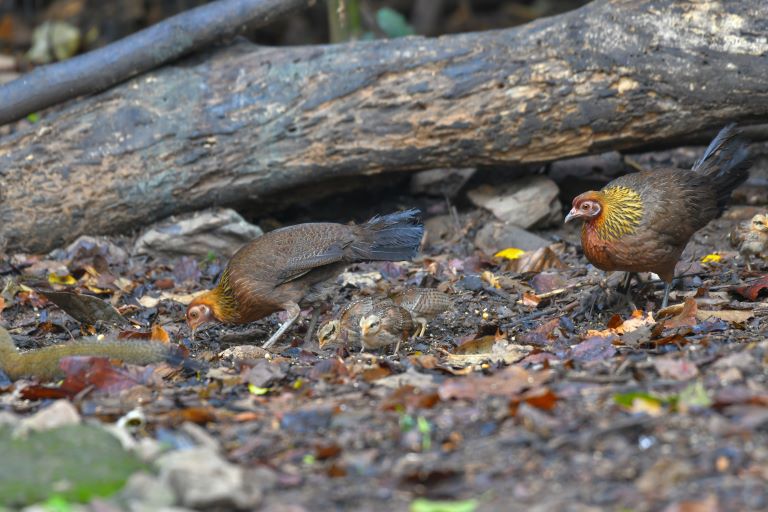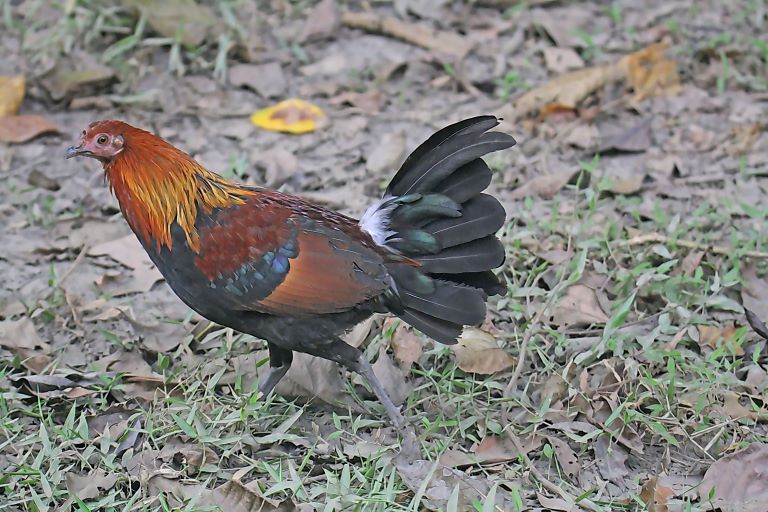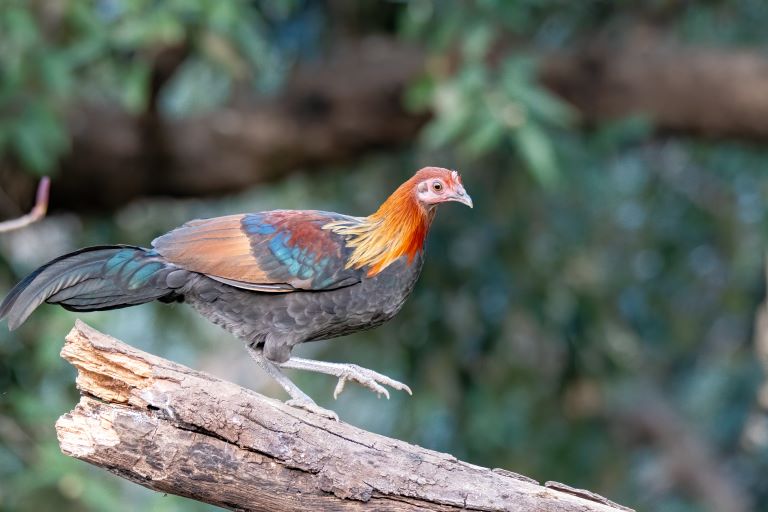Red Junglefowl Profile
The common chicken is a notoriously derpy animal that retains many strong Therapod attributes like the cold, dead eyes of a killer and the ability to steal a fresh rat carcass from a house cat and swallow it whole.
Chickens are one of the oldest domesticated animals, but their wild equivalents were such low-maintenance that they didn’t need to change much, so if you pick out some of the best-looking, most athletic and striking examples of a male domestic chicken, it’s likely you’ll be looking at something that very closely resembles its ancestor, the red junglefowl.

Red Junglefowl Facts Overview
| Habitat: | Jungle; disturbed edges with cover, natural or artificial, agricultural |
| Location: | India, Nepal to China, South to Singapore, Philippines, Indonesia |
| Lifespan: | 12-15 years |
| Size: | Up to 77 cm (28 in) long with a 28 cm (11 in) tail in roosters |
| Weight: | Up to 1.5 kg (3+1⁄4 lbs) |
| Colour: | Males bright golden brown, with dark iridescent tail feathers and red wattle |
| Diet: | Seeds, fruits and nuts, also insects, lizards, small mammals |
| Predators: | Raptors, snakes, coucals, rodents |
| Top Speed: | Not listed |
| No. of Species: | 1 |
| Conservation Status: | Least Concern (IUCN) |
The red junglefowl is a beautiful chicken from the pheasant family.
It’s the original Foghorn Leghorn, a slender, more agile and lighter version of the domesticated chicken, whose shift from an ornamental bird towards a food source is still being figured out.
These birds originate from Southeast Asia, and are still doing fairly well to this day, a clear example of what all chickens once were, and a reminder that they’re more than mindless drumsticks and have a life and a mind outside that of the farm animal they’ve been bred to be.
Interesting Red Junglefowl Facts
1. They’re chickens
The pheasant family is rich in good-looking terrestrial bird species, including most of the best-known domesticated breeds like the partridge, peacock and quail. It’s also where the domestic chicken, the most numerous bird on the planet, lives.
But before there were chickens there were junglefowl. The similarities in appearance are no coincidence; this is the ancestral form of the domesticated chicken, having diverged only around 10,000 years ago (until better evidence comes out) when a group of these beautiful birds were captively bred and their domestication began.
So, the breeds haven’t been separated for long and are still the same species, Gallus gallus, an inherently genetically diverse species already, with some evidence that there is a little input of genes from the green junglefowl in the domestic chicken too.
This domestication event occurred in Asia, which makes sense, as that’s where red junglefowl live. And the male in particular looks like a stunning example of a rooster, more slender and smaller than the swollen food-based breeds have come to be. 1

2. They were ornamental
Chickens have been bred for thousands of years to get fatter and slower so there’s more meat that’s easier to catch, but even after domestication, it took a while for the jungle fowl to be considered food.
To begin with, it appears that the birds were kept for their beauty, much like the peacock is now. It was relatively recently that someone got desperate enough to eat their furniture and realised it sits well with some jerk sauce and a burger bun.
From chicken fossils, researchers have been able to get enough DNA to suggest that it took each culture around 500 years to figure this out. Junglefowl were introduced to a region, and around 500 years later they started to become bred for food: fatter, slower, and more fecund with eggs. 2
3. Females are duller
There are many ways that the domesticated chicken differs from its ancestry. In the West, it’s common to assume daily egg production is a natural part of chicken life, but this is actually a trait that’s been selectively bred for, and puts a significant strain on the physiology of the bird.
In the wild, hens will only lay one or two unfertilised eggs a year, if any, and will mostly only lay when there’s a rooster present.
And while the rooster is a true beauty of a bird, as is often still the case in domestic fowl, the junglefowl hens are substantially duller. This is a work of camouflage, as she’ll be the one responsible for looking after and hiding her offspring. 3

4. They roost high up
Chickens prefer roosting off the ground, but junglefowl take it quite a bit further. Females choose a median height of around 7 metres for their roosting spot, and the males are king of the coop at 12 metres above the ground, where they can keep a watchful eye over their domain.
5. Nest predation is a big threat
This is a product of the far more dangerous environment they find themselves in. Wild junglefowl suffer a lot from nest predation, and nest success is just under a third; around half of which is attributed to predators.
Rodents, reptiles, and coucals are the main nest predators of red junglefowl. 4
6. Roosters crow in shorthand
Another stark difference between the old school and the new is the sound that the males make to assert their position.
The classic crowing of the rooster that we’re familiar with is a recognisable adaptation from the junglefowl, but it appears to have been selected for – or perhaps changed randomly – to be more complex than the junglefowl’s.
A junglefowl territorial crow is, much like the original Nokia tune, cut short before the final notes.
7. They may have come with rice
The specific origins of the chicken are still being figured out, but while chicken and rice are a staple of Asian cuisine, before this was a gastronomic pairing, it was a practical one.
In fact, without the development of rice, it’s suggested that the domestic chicken may not have come about.
Around the time people started cultivating rice, junglefowl began to appear in gardens. Perhaps they were lured in by grains, even used as pest control, or considered a pest themselves.
This idea would put the age of domestication a lot more recently than is currently inferred, but it remains an interesting idea to investigate.

8. They’re smart
Chickens are pretty good at playing dumb. Like fish, their lack of facial expressions, tendency to panic, and all-round mindless appearance allow us to excuse our behaviour towards them as victimless.
But chickens are our most abundant farm animal and one of the most abundant animals on the planet as a result. And the more we study them closer, the more we realise they have sophisticated, if a little unfamiliar, levels of cognition.
The same is true with the junglefowl, and the similarities are enough that researchers are comfortable conflating both the wild and domestic breeds in reports on their intelligence.
The takeaway here is that while we would certainly be happier if chickens were as dumb and incapable of suffering as they look, the reality is impossible to deny honestly and if we can’t stop killing them, we should at least be giving them a good life while they have it.
Thankfully, Junglefowl appear to be living a pretty good life as it is, and are listed as Least Concern by the IUCN, but their population is still decreasing.
Red Junglefowl Fact-File Summary
Scientific Classification
| Kingdom: | Animalia |
| Phylum: | Chordata |
| Class: | Aves |
| Order: | Galliformes |
| Family: | Phasanidae |
| Genus: | Gallus |
| Species: | gallus |
Fact Sources & References
- A Fumihito (1994), “One subspecies of the red junglefowl (Gallus gallus gallus) suffices as the matriarchic ancestor of all domestic breeds”, PNAS.
- Ann Gibbons (2022), “How the wild jungle fowl became the chicken”, Science.
- Birding with Brian (2023), “Amazing Birds of Thailand”, YouTube.
- Xiaodong Rao (2023), “Nesting success and potential nest predators of the red Junglefowl (Gallus gallus jabouillei) based on camera traps and artificial nest experiments”, frontiers.
